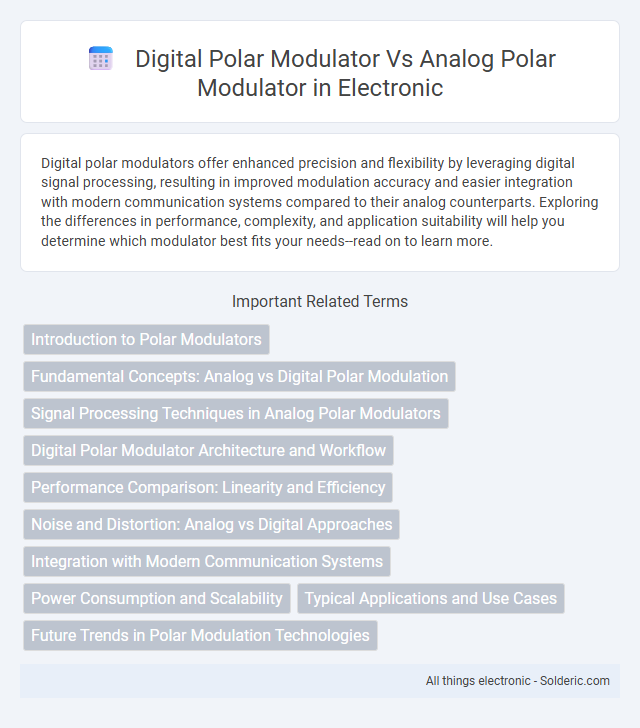Digital polar modulators offer enhanced precision and flexibility by leveraging digital signal processing, resulting in improved modulation accuracy and easier integration with modern communication systems compared to their analog counterparts. Exploring the differences in performance, complexity, and application suitability will help you determine which modulator best fits your needs--read on to learn more.
Comparison Table
| Feature | Digital Polar Modulator | Analog Polar Modulator |
|---|---|---|
| Signal Processing | Digital baseband processing; high precision | Analog domain processing; susceptible to distortion |
| Linearity | High linearity due to digital control | Lower linearity; affected by component nonlinearity |
| Power Efficiency | Improved efficiency with digital techniques | Less efficient; analog components consume more power |
| Implementation Complexity | Higher complexity; requires digital signal processors | Simpler design; analog circuits easier to implement |
| Flexibility | Highly flexible; supports adaptive modulation | Limited flexibility; fixed modulation scheme |
| Noise Immunity | Better noise immunity via digital filtering | More noise sensitivity; prone to analog noise |
| Cost | Higher cost due to DSPs and converters | Lower cost with simpler analog components |
| Integration | Easier integration with modern digital systems | Challenging integration; separate analog blocks required |
Introduction to Polar Modulators
Polar modulators convert amplitude and phase signals into a constant envelope output, improving power amplifier efficiency in communication systems. Digital polar modulators offer precise signal processing, reduced distortion, and better integration with modern digital communication standards compared to analog polar modulators. Your choice depends on system requirements, where digital solutions provide enhanced flexibility and performance for advanced wireless applications.
Fundamental Concepts: Analog vs Digital Polar Modulation
Analog polar modulators convert amplitude and phase information into continuous-time signals using analog circuits, ensuring real-time modulation with simpler hardware. Digital polar modulators process baseband signals digitally, utilizing algorithms to separate amplitude and phase components, providing higher accuracy, flexibility, and improved spectral efficiency. The digital approach enables advanced correction techniques, reduced distortion, and easier integration with modern digital communication systems compared to traditional analog implementations.
Signal Processing Techniques in Analog Polar Modulators
Analog polar modulators utilize continuous-time signal processing techniques, such as phase and amplitude modulation through analog mixers, phase shifters, and envelope detectors, enabling real-time modulation with minimal latency. They rely on analog signal components to separate and manipulate the amplitude and phase signals directly, which can introduce distortion due to component nonlinearity and temperature variations. Your choice of modulator impacts system complexity, with analog solutions offering simpler design but less flexibility compared to digital polar modulators' programmable digital signal processing capabilities.
Digital Polar Modulator Architecture and Workflow
Digital polar modulators utilize advanced signal processing algorithms to separately handle amplitude and phase components, enabling precise control and improved spectral efficiency compared to analog counterparts. The digital architecture involves converting the input signal into polar coordinates, processing amplitude digitally, and then using a high-speed DAC combined with an RF phase modulator to reconstruct the signal. Your system benefits from reduced distortion and enhanced linearity due to the digital polar modulator's ability to dynamically adjust modulation parameters in real-time.
Performance Comparison: Linearity and Efficiency
Digital polar modulators exhibit superior linearity compared to analog polar modulators due to precise digital signal processing that minimizes phase and amplitude distortions. Analog polar modulators often suffer from non-linearities caused by analog component imperfections, leading to signal distortion and reduced performance. In terms of efficiency, digital polar modulators enable adaptive control schemes that optimize power consumption and minimize signal degradation, whereas analog modulators typically operate with fixed characteristics, limiting overall energy efficiency.
Noise and Distortion: Analog vs Digital Approaches
Digital polar modulators offer significantly lower noise and distortion levels compared to analog polar modulators due to precise signal processing and error correction algorithms that minimize phase and amplitude errors. Analog polar modulators are more susceptible to component variations and thermal noise, resulting in higher distortion and reduced signal fidelity. Your communication system benefits from digital solutions by achieving improved spectral efficiency and enhanced signal integrity.
Integration with Modern Communication Systems
Digital polar modulators offer superior integration with modern communication systems due to their compatibility with software-defined radio (SDR) architectures and advanced signal processing algorithms. Unlike analog polar modulators, digital versions enable precise control over phase and amplitude, enhancing spectral efficiency and reducing distortion in complex modulation schemes such as QAM and PSK. This integration facilitates real-time adaptability, support for multiple standards, and seamless deployment in 5G and beyond communication networks.
Power Consumption and Scalability
Digital polar modulators offer significantly lower power consumption compared to analog polar modulators due to their efficient digital signal processing and reduced analog circuit complexity. Scalability in digital polar modulators is enhanced by advanced CMOS technology, enabling seamless integration and adaptation to multi-band and multi-standard wireless systems. Analog polar modulators face challenges in scalability due to their reliance on discrete components and higher power dissipation in analog signal chains, limiting their efficiency in large-scale, multi-frequency applications.
Typical Applications and Use Cases
Digital polar modulators are commonly used in advanced wireless communication systems like 5G, satellite transceivers, and software-defined radios due to their high precision and flexibility in signal processing. Analog polar modulators find typical applications in simpler RF transmitters, such as traditional AM radios and some radar systems, where lower complexity and cost are prioritized. Your choice depends on the required signal quality and system complexity, with digital modulators excelling in modern, high-performance applications and analog modulators serving legacy or cost-sensitive designs.
Future Trends in Polar Modulation Technologies
Future trends in polar modulation technologies emphasize advanced digital polar modulators due to their superior accuracy, flexibility, and integration capabilities with modern communication standards such as 5G and beyond. Digital polar modulators utilize sophisticated signal processing algorithms that enhance spectral efficiency while reducing power consumption compared to traditional analog polar modulators. The shift towards digital solutions supports adaptive modulation schemes and AI-driven optimization, driving improvements in performance for next-generation wireless systems.
Digital polar modulator vs analog polar modulator Infographic

 solderic.com
solderic.com